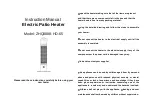
Tools:• Silicone Sealant, (GE II or equivalent)
• Screwdriver or 5/16” nutdriver
• Ratchet or speed wrench to drive lag screws
Remove the collector from the box and allow the material to
relax in the sun (30 minutes to an hour). Do not lay the collector
on the grass - it can burn the lawn underneath. Allow at least
one foot around the solar system for brackets and piping. Roof
obstructions like vents should be taken into consideration when
laying out collectors. With a roof vent up to 3” in diameter, the
collectors can be placed on either side of the vent.
Determine the position of the top collector. The mounting
bracket will be located at each slot along the length of the
collector. The row should slope slightly toward the inlet point
(where the water enters the collectors) to allow for drainage.
Drill 1/8” holes for a 1/4” lag screw for all brackets. Lag screws
should be long enough to reach the subroof under the shingles.
Inject a generous amount of silicone sealant into the holes and
onto the surrounding roof surface. Mount the bracket to the roof
as shown with the bracket centered in the slot.
CONNECT THE
C O L L E C T O R S
SunHeater solar collectors are modular and can be easily
connected by using the hardware provided using a screwdriver
or nutdriver. The ends of the headers on each collector are
machined to seat the collector hoses and to seal off where
the clamps are tightened.
Slip the connector hoses up to, but not over, the shoulder
groove. Locate the hose clamps 3/8” in from the end of each
hose to center them over the grooves on the header and tight-
en (Do Not Overtighten). The hose clamps must be located
over the grooves in the header.
Finish connecting collectors by inserting the endcap and vacu-
um relief end cap at diagonal ends of the collector row. The
vacuum relief end cap (shown at left), allows the system to
drain down and is inserted at the top of the system.
1
MOUNT THE
C O L L E C T O R S
2
5


































